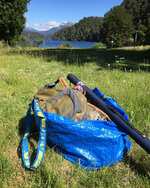I used to write for some fly fishing magazines, go to the annual FF trade show, etc. Not that I'm all knowing or even close, but I have gotten to handle, cast, and fish thousands of fly rods over the years. One of the earlier posters stated the best way to start the quest for the "best" rod - - - begin with the fly line you'll be using most. After all, the lines are built to (in theory) standard weights (based on the first 30 feet of the head, minus the front tip). A telling example: At the trade shows, rod makers have all their rods set up with line, leader and a "fly" (typically a bit of yarn) so shop owners can cast them. At one show, I watched a dealer who was carrying his own reel and line around, and took the rod maker's reel off the rod, and used his own to cast it. I asked him about that, and he confirmed that, because he had no idea which (as an example) 5-wt line the maker had on his reel, he wanted to test cast the rod with a line he knew was a correctly-sized 5-wt.
As an example, for trout, say a 4- or 5-weight floating line is preferred. The most popular are weight forward lines. RIO and SA/Orvis are probably the largest selling, and probably have the most "thought" (core and coating chemistry, tapers, etc.) put into the products. A 6-wt is maybe a bit heavy for small and medium trout streams w/ little wind, and a little light for bass, if you'll be tossing bulky, wind-resistant bugs. But, you'll have to decide if one outfit is enough (is one rifle enough?)
Reels, unless you're going to be catching long- and strong-running fish, and need a good drag, are line holders. "Decent" is OK for trout and bass.
Rods . . . well, fly anglers will argue over which rod is "best" just like hunters will debate which brand of rifle is best. And like both, or like bows, it's the archer and not the arrow.
The top-tier rods (now bouncing all around $1,000 in some cases) do have a lot of thought, the latest/greatest materials and adhesives, and fine-tuning of tapers. All that cost money. Whether that's worth it, or one needs it is - - - well, it's up to the angler and his/her checkbook. In general, though, "value-priced" rod makerss such as TFO, Echo, etc. have gone offshore to get reduced labor costs, and have produced some really nice rods. Are they as "good" as the best Sage, Orvis, Winston, Loomis, etc. rods? Again, that's up to the buyer. Does a Honda perform as well as a Porsche? Or is it a case of does it do what you want it to do, or is it capable of doing all you can do with it? Can you make curve casts or slack line casts or mend line better with Brand X than Brand Y? Can you cast 100 feet with either? Does that matter? More importantly, can you make 30 - 50 foot casts with less effort and fewer false casts with one that the other. You know, normal fishing casts!
Back to the main point - - - start with the line. If at all possible, line, leader and a fly (with the barb cut off) that is the typical setup you'll be using. Try a bunch of rods at the local shop with that typical setup (realizing there's nothing like asphalt or concrete to ruin a fly line). Pick the shop owner's brain.
You CAN spend $1,000 on a rod, that much on a reel as well (OK, mostly in the larger, saltwater sizes), and $100 on a line. OR, you can shop judiciously, and find some perfectly serviceable complete outfits for less than half that $1,000 bill.
Finally, let me revisit that discussion of the warranty. The "lifetime warranty", when it was introduced a few decades ago, seemed like a pretty good idea. After all, most fly anglers take really good care of their equipment . . . except for a couple of things. One is that the idea seemed to grow that they didn't have to, because they could get a problem fixed for "free". The other was that, because of "The Movie" (A River Runs Through It), fly fishing became a "thing to do", bringing in a lot of new anglers. Which was great, except some didn't realize that "high sticking" could result in a broken tip, as could casting tailing loops using a weighted nymph or split shot. And, oh yeah, I didn't see that limb sticking out from the tree behind me. Thus "free" changed to "free" with a handling fee to it's just not "free" any more under many warranties.
Bottom line, as advised earlier, go to the local shop, try rods, ask questions, buy one, and go home happy that you've made an informed choice.

